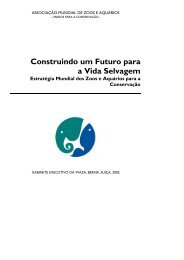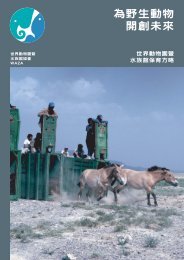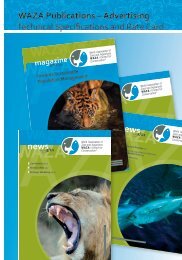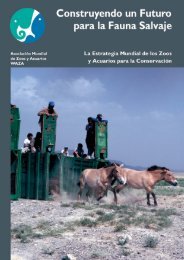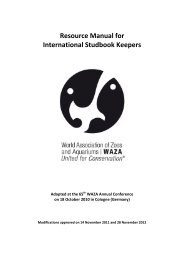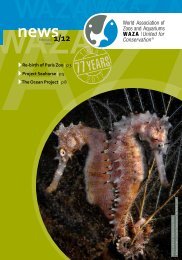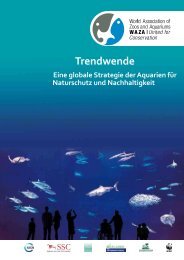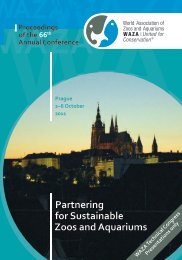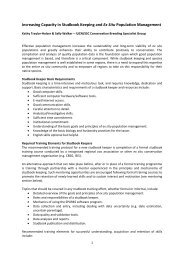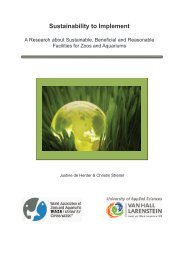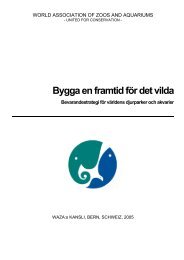Towards Sustainable Population Management - Waza
Towards Sustainable Population Management - Waza
Towards Sustainable Population Management - Waza
Create successful ePaper yourself
Turn your PDF publications into a flip-book with our unique Google optimized e-Paper software.
WAZA magazine Vol 12/2011 11<br />
Kristin Leus 1,2 *, Laurie Bingaman Lackey 3 , William van Lint 1 ,<br />
Danny de Man 1 , Sanne Riewald 4 , Anne Veldkam 4 & Joyce Wijmans 4<br />
Sustainability of European<br />
Association of Zoos and Aquaria<br />
Bird and Mammal <strong>Population</strong>s<br />
Introduction<br />
A rapid assessment of the sustainability<br />
of bird and mammal populations<br />
managed by the European Association<br />
of Zoos and Aquaria (EAZA) as<br />
European Endangered Species Programmes<br />
(EEPs) and European Studbooks<br />
(ESBs) was initiated in 2008, in<br />
response to concerns arising from the<br />
European Union (EU) bird import ban<br />
triggered by avian influenza. There is<br />
as yet no such blanket ban for mammal<br />
populations, but we have already<br />
experienced transport restrictions<br />
for various groups of mammals in<br />
response to disease outbreaks, such<br />
as bluetongue, bovine spongiform<br />
encephalopathy (BSE) and foot-andmouth.<br />
All of this begs the questions<br />
“are, or can, EAZA bird and mammal<br />
populations be sustainable” and<br />
“what do we mean by sustainable”?<br />
1 European Association of Zoos<br />
and Aquaria, Amsterdam,<br />
The Netherlands<br />
2 IUCN/SSC Conservation Breeding<br />
Specialist Group Europe,<br />
c/o Copenhagen Zoo,<br />
p/a Merksem, Belgium<br />
3 International Species Information<br />
System, Eagan, MN, USA<br />
4 Van Hall Larenstein University<br />
of Applied Sciences, Leeuwarden,<br />
The Netherlands<br />
* E-mail for correspondence:<br />
kristin@cbsgeurope.eu<br />
Self-sustainability generally implies<br />
that a population can remain genetically<br />
and demographically healthy<br />
without further importation. For the<br />
time being, the “default” criterion<br />
for genetic self-sustainability of zoo<br />
populations is that the captive population<br />
be able to maintain 90% of the<br />
genetic diversity of the wild population<br />
for 100 years without further<br />
imports. The demographic factor is<br />
equally important and is a precondition<br />
for genetic sustainability. Genetic<br />
diversity comes “wrapped up” in<br />
living individuals. A population that is<br />
losing individuals is therefore always<br />
losing gene diversity – when the animals<br />
are gone, the genes are gone.<br />
Are EAZA bird and mammal populations<br />
demographically self-sustainable?<br />
Demographic self-sustainability<br />
implies that, on average, the number<br />
of births and hatches is as high, or<br />
higher, than the number of deaths<br />
(and, where relevant, exports). If<br />
imports into the EU are becoming<br />
(more) restricted, then we will have<br />
to rely on births and hatches in EAZA<br />
collections or high quality private<br />
and/or non-EAZA collections in the<br />
EU to counteract deaths and removals<br />
of individuals from the population<br />
for other reasons. This is easy to say<br />
but hard to track. Although it is encouraging<br />
that the number of EAZA<br />
institutions joining the International<br />
Species Information System (ISIS)<br />
has rapidly increased over the years,<br />
some zoos are not yet members; not<br />
all zoos have entered all their data;<br />
data are not always up to date; and<br />
the origin of individuals is not always<br />
clear. Analysing the EAZA data in ISIS<br />
will therefore be time-consuming and<br />
not always successful. We therefore<br />
decided to evaluate the EAZA EEP<br />
and ESB bird and mammal populations<br />
by utilising the SPARKS studbook<br />
databases. Furthermore, one<br />
would normally expect that more of<br />
the managed populations are selfsustainable<br />
than are non-managed<br />
populations.<br />
»



